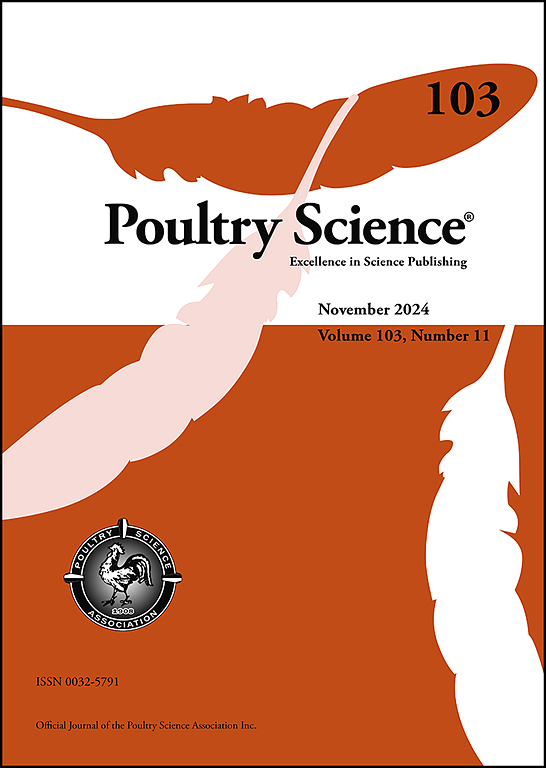脂质组学揭示了鸡胚胎发育后期肝脏脂质变化
IF 3.8
1区 农林科学
Q1 AGRICULTURE, DAIRY & ANIMAL SCIENCE
引用次数: 0
摘要
在鸡胚胎发育后期,肝脏发生了显著的代谢变化,尤其是脂质代谢。脂质是鸡胚生长发育的重要能量来源和结构成分。然而,在这个关键的发育窗口期,肝脂质组成的动态变化尚不清楚。为了探讨脂质组成的变化及其机制,我们在两个关键发育时间点(E14和D1)对鸡胚胎肝脏进行了研究。结果表明,D1组肝脏脂滴积累明显大于E14组。生化分析显示,D1组肝脏甘油三酯、总胆固醇、高密度脂蛋白胆固醇和低密度脂蛋白胆固醇水平明显高于E14组。此外,我们进行了脂质组学分析,鉴定出鸡肝脏中2274种脂质,主要由甘油脂和甘油磷脂组成。主成分分析和偏最小二乘判别分析的评分图显示,E14组和D1组的肝脏脂质特征明显不同,提示鸡胚胎发育后期肝脏脂质组成和代谢可能发生重构。同时,共鉴定出105种差异丰富的脂质,其中D1组与E14组相比,91种脂质显著上调,14种脂质显著下调。途径分析显示,该途径富含37种不同含量的脂质,这些脂质可能在鸡胚胎后期的生长发育中起关键作用。综上所述,本研究旨在研究鸡胚胎发育后期肝脏的营养需求,并对发育中肝脏的脂质组成和种类的变化进行分析。研究结果可用于提高肉鸡品质和生产性能。本文章由计算机程序翻译,如有差异,请以英文原文为准。
Lipidomics reveals lipid changes in the hepatic during the late chick embryonic development
The liver undergoes significant metabolic changes during the late stage of chick embryonic development, particularly in lipid metabolism. Lipids are critical energy sources and structural components for the growth and development of chicken embryos. However, the dynamic changes in hepatic lipid composition during this critical developmental window remain unclear. To investigate the lipid composition changes and underlying mechanisms, we conducted a study on chick embryonic livers at two key developmental time points (E14 and D1). The results showed that the liver in the D1 group exhibited greater lipid droplet accumulation compared to the E14 group. Biochemical analysis revealed significantly elevated levels of triglycerides, total cholesterol, high-density lipoprotein cholesterol, and low-density lipoprotein cholesterol in the liver of the D1 group relative to the E14 group. Furthermore, we performed lipidomics analysis and identified 2274 lipid species in chicken liver, which were predominantly composed of glycerolipids and glycerophospholipids. Score plots of principal component analysis and partial least squares discriminant analysis revealed distinct lipid profiles between the E14 and D1 groups, suggesting potential remodeling of liver lipid composition and metabolism during the late stage of chick embryonic development. Meanwhile, a total of 105 differentially abundant lipid species were identified, with 91 significantly upregulated and 14 significantly downregulated in the D1 group compared to the E14 group. Pathway analysis revealed the enrichment of the glycerophospholipid metabolic pathway, which comprises 37 differentially abundant lipids that may play crucial roles in the growth and development of chick embryos during late stages. In summary, this study characterized the liver lipid profile and explored the changes in lipid composition and species of the developing liver, with the aim of identifying the nutritional requirements of chicken embryos in the late stages of development. These findings could be utilized for improving chick quality and broiler performance.
求助全文
通过发布文献求助,成功后即可免费获取论文全文。
去求助
来源期刊

Poultry Science
农林科学-奶制品与动物科学
CiteScore
7.60
自引率
15.90%
发文量
0
审稿时长
94 days
期刊介绍:
First self-published in 1921, Poultry Science is an internationally renowned monthly journal, known as the authoritative source for a broad range of poultry information and high-caliber research. The journal plays a pivotal role in the dissemination of preeminent poultry-related knowledge across all disciplines. As of January 2020, Poultry Science will become an Open Access journal with no subscription charges, meaning authors who publish here can make their research immediately, permanently, and freely accessible worldwide while retaining copyright to their work. Papers submitted for publication after October 1, 2019 will be published as Open Access papers.
An international journal, Poultry Science publishes original papers, research notes, symposium papers, and reviews of basic science as applied to poultry. This authoritative source of poultry information is consistently ranked by ISI Impact Factor as one of the top 10 agriculture, dairy and animal science journals to deliver high-caliber research. Currently it is the highest-ranked (by Impact Factor and Eigenfactor) journal dedicated to publishing poultry research. Subject areas include breeding, genetics, education, production, management, environment, health, behavior, welfare, immunology, molecular biology, metabolism, nutrition, physiology, reproduction, processing, and products.
 求助内容:
求助内容: 应助结果提醒方式:
应助结果提醒方式:


